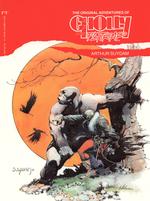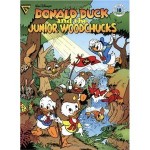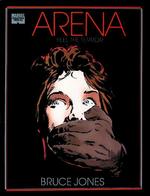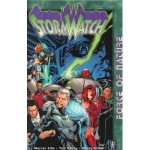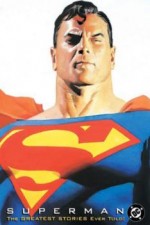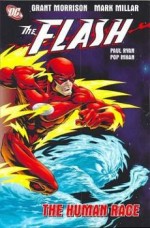
By Grant Morrison, Mark Millar, Paul Ryan, Ron Wagner, Pop Mahn & various (DC Comics)
ISBN: 978-1-84856-382-7
There are many super-speedsters in the DCU and most of them congregate in the conjoined metropolis of Keystone and Central City. Wally West, third incarnation of The Flash, lives there with his true love Linda Park, his Aunt Iris and fellow fast-fighters such as Jay Garrick. Impulse, a juvenile speedster from the Future and his mentor/keeper Max Mercury – the Zen Master of hyper-velocity – live in Alabama but often visit as they only live picoseconds away…
Created by Gardner Fox and Harry Lampert, Garrick debuted as the very first Scarlet Speedster in Flash Comics #1 (January 1940). “The Fastest Man Alive†wowed readers for over a decade before changing tastes benched him in 1951 until the concept of speedsters and superheroes in general was revived in 1956 by Julie Schwartz in Showcase #4 when police scientist Barry Allen became the second hero to run with the concept.
The Silver Age Flash, whose creation ushered in a new and seemingly unstoppable era of costumed crusaders, died heroically during Crisis on Infinite Earths (1985-1986) and was promptly succeeded by his sidekick Kid Flash. Of course Allen later returned from the dead – but doesn’t everyone?
Initially Wally West struggled to fill the boots of his predecessor, both in sheer ability and, more tellingly, in confidence. Feeling a fraud, he nonetheless persevered and eventually overcame, becoming the greatest to carry the name.
Following directly on from Morrison and Millar’s first turn on the Scarlet Speedster (see Flash: Terminal Velocity) this volume reprints issues #136-141 of the monthly comic and even finds room for a delicious extra feature from Secret Origins #50 and opens with a 10-year-old Wally playing with his Ham Radio kit and talking to an imaginary friend before we sprint into the present-day to find Wally seconds after his last exploit, when an alien super-speedster crashed at his feet, gasping out a warning with his dying breath…
The eponymous three-part lead tale The Human Race commences with ‘Radio Days’ (written by Morrison & Millar with art by the under-appreciated Paul Ryan and John Nyberg) when two god-like alien gamblers materialise and demand that Earth’s fastest inhabitant replaces the dead runner in a race across all time and space. If a contestant isn’t provided the world is forfeit and will be destroyed…
With the Justice League unable to defeat the cosmic wagerers Flash has no choice but to compete, however he almost falls apart when discovers his opponent is Krakkl, a radio-wave lifeform who used to talk to him when he was a kid. Now Wally has to beat a beloved memory he thought a mere childhood fancy to save his homeworld… and if he does, Krakkl’s entire species will die…
Ron Wagner came aboard as penciller for ‘Runner’ and ‘Home Run’ as, pushed to the limits of endurance and imagination Flash criss-crosses all reality but soon realises this a match he cannot win… until the valiant, self-sacrificing radio-racer imparts a deadly and world-saving secret…
Cosmic, clever and deeply sentimental in the fashion comics-fans are suckers for, this stunning saga ends with Earth enduring but its victorious hero on course for the ultimate finish in the tense thriller The Black Flash (Miller, Pop Mahn & Chris Ivy, with additional pencils from Joshua Hood) as a demonic entity that abides beyond the velocity-fuelling energy field the Speed Force comes for him in ‘The Late Wally West’.
Older speedsters have noticed over the decades that their ultra-swift comrades have all been hunted and taken by this supernal beast before their lives ended and when the creature is seen stalking Wally they do all they can to thwart it. Tragically they succeed… Unable to kill the Flash, the thing destroys his beloved Linda instead…
Jesse Quick, second generation hero who lost her father to the Black Flash, takes over Wally’s role as crushed, depressed and broken Wally loses his connection to the Speed Force, but after weeks of shell-shocked mourning he moves on, planning a new life in a foreign country, but the Black Flash is spiteful and never gives up…
When the beast attacks the powerless Wally at the airport in ‘The End’ Max Mercury, Garrick, Impulse and Jesse all confront the creature until the true Scarlet Speedster rediscovers the inner fire necessary to not only face and defeat the thing but also bring back Linda from the Great Unknown.
As if that wasn’t a perfect ending to this tumultuous tome there’s also a lost gem drawn by the magnificent Mike Parobeck (although probably included here because it’s one of Grant Morrison’s earliest DC scripts), inked by Romeo Tanghal which originally debuted in Secret Origins #50 in 1990 in celebration of Flash’s 50th anniversary.
By the early 1950s costumed heroes had lost popularity and all but disappeared from comicbook pages for half a decade. The concept was revived and took off again when the Barry Allen Flash debuted in Showcase #4. ‘Flash of Two Worlds’ by Fox, Carmine Infantino and Joe Giella (from Flash #123, 1961) revived the Golden Age Flash, and by implication, the whole 1940s DC pantheon by introducing the concept of parallel worlds and multiple Earths which became the bedrock of the entire continuity.
The aforementioned Crisis on Infinite Earths rationalised that continuity, retconning DC’s history so that all its characters had always shared the same planet and dimension. Simple, no…?
This new ‘Flash of Two Worlds’ saw Morrison and Parobeck retell the landmark adventure of how Barry met Jay, keeping the wonder and thrills intact, incorporating a classic combat with arch-villains Fiddler, Thinker and the Shade and even found room for a little in-joke surprise or two…
Fast, furious and fabulous the Flash has always epitomised the best in costumed comic thrills and these tales are among the very best. If you haven’t seen them yet, run – don’t walk – to your nearest emporium or vendor-site and catch all the breathless action you can handle, A.S.A.P!
© 1990, 1998, 2009 DC Comics. All Rights Reserved.

